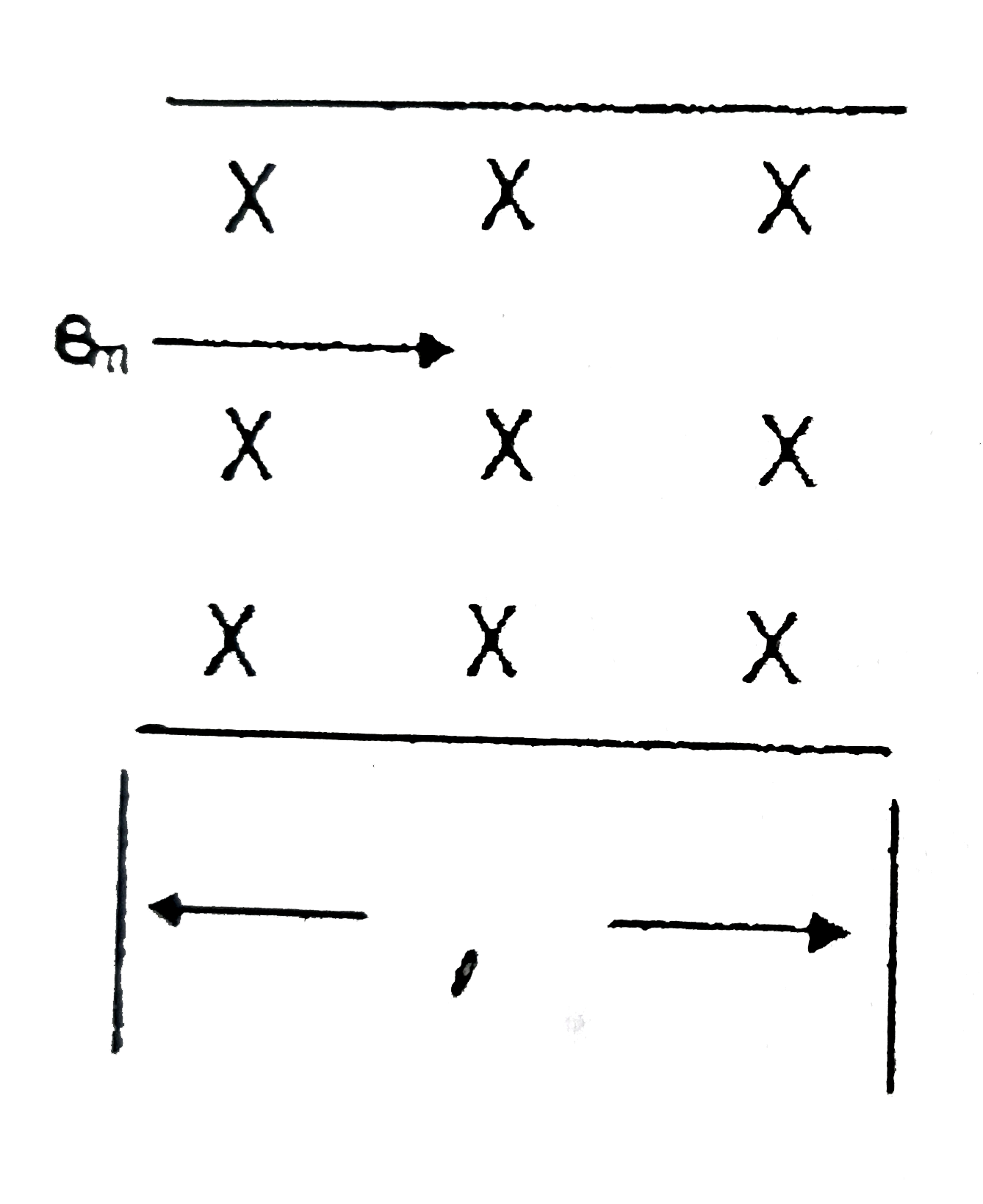A particle of mass 2×10−5kg moves horizontally between two horizontal plates of a charged parallel plate capacitor between which there is an electric field of 200NC−1 acting upward. A magnetic induction of 2.0 T is applied at right angles to the electric field in a direction normal to both →Band→v. If g is 9.8ms−2 and the charge on the particle is 10−6C, then find the velocity of charge particle so that it continues to move horizontally
2ms−1
20ms−1
0.2ms−1
100ms−1
The correct Answer is:a
To solve the problem, we need to find the velocity of a charged particle moving horizontally in the presence of an electric field and a magnetic field such that it experiences no vertical deflection. Here are the steps to arrive at the solution:
Step 1: Identify the Forces Acting on the Particle
The particle experiences three forces:
1. Electric Force (F_e): This is due to the electric field acting on the charge.
2. Gravitational Force (F_g): This is due to the weight of the particle.
3. Magnetic Force (F_m): This is due to the motion of the charged particle in the magnetic field.
Step 2: Calculate the Electric Force
The electric force can be calculated using the formula:
Fe=qE
Where:
- q=10−6C (charge of the particle)
- E=200N/C (electric field strength)
Substituting the values:
Fe=(10−6C)×(200N/C)=2×10−4N
Step 3: Calculate the Gravitational Force
The gravitational force can be calculated using the formula:
Fg=mg
Where:
- m=2×10−5kg (mass of the particle)
- g=9.8m/s2 (acceleration due to gravity)
Substituting the values:
Fg=(2×10−5kg)×(9.8m/s2)=1.96×10−4N
Step 4: Set Up the Equation for No Vertical Deflection
For the particle to continue moving horizontally without deflection, the net vertical force must be zero. Therefore, we set up the equation:
Fe=Fg+Fm
Where Fm is the magnetic force given by:
Fm=qvB
Where:
- B=2.0T (magnetic induction)
- v is the velocity of the particle.
Substituting the forces into the equation:
2×10−4=1.96×10−4+(10−6)v(2.0)
Step 5: Solve for the Velocity v
Rearranging the equation gives:
2×10−4−1.96×10−4=(10−6)v(2.0)
0.04×10−4=(10−6)v(2.0)
0.04×10−4=2×10−6v
Dividing both sides by 2×10−6:
v=0.04×10−42×10−6
v=0.042×102
v=0.02×102
v=2m/s
Final Answer
The velocity of the charged particle so that it continues to move horizontally is:
2m/s
The particle experiences three forces:
1. Electric Force (F_e): This is due to the electric field acting on the charge.
2. Gravitational Force (F_g): This is due to the weight of the particle.
3. Magnetic Force (F_m): This is due to the motion of the charged particle in the magnetic field.
The electric force can be calculated using the formula:
Fe=qE
Where:
- q=10−6C (charge of the particle)
- E=200N/C (electric field strength)
Fe=(10−6C)×(200N/C)=2×10−4N
The gravitational force can be calculated using the formula:
Fg=mg
Where:
- m=2×10−5kg (mass of the particle)
- g=9.8m/s2 (acceleration due to gravity)
Fg=(2×10−5kg)×(9.8m/s2)=1.96×10−4N
For the particle to continue moving horizontally without deflection, the net vertical force must be zero. Therefore, we set up the equation:
Fe=Fg+Fm
Where Fm is the magnetic force given by:
Fm=qvB
Where:
- B=2.0T (magnetic induction)
- v is the velocity of the particle.
2×10−4=1.96×10−4+(10−6)v(2.0)
Rearranging the equation gives:
2×10−4−1.96×10−4=(10−6)v(2.0)
0.04×10−4=(10−6)v(2.0)
0.04×10−4=2×10−6v
v=0.04×10−42×10−6
v=0.042×102
v=0.02×102
v=2m/s
The velocity of the charged particle so that it continues to move horizontally is:
2m/s
Topper's Solved these Questions
- MAGNETIC FIELD AND MAGNETIC FORCESBOOK - CENGAGE PHYSICS ENGLISHCHAPTER - MAGNETIC FIELD AND MAGNETIC FORCESEXERCISE - Exercises Multiple Correct
25 Videos
- MAGNETIC FIELD AND MAGNETIC FORCESBOOK - CENGAGE PHYSICS ENGLISHCHAPTER - MAGNETIC FIELD AND MAGNETIC FORCESEXERCISE - Exercises Assertion -reasoning
8 Videos
- MAGNETIC FIELD AND MAGNETIC FORCESBOOK - CENGAGE PHYSICS ENGLISHCHAPTER - MAGNETIC FIELD AND MAGNETIC FORCESEXERCISE - Exercises Subjective
10 Videos
- INDUCTANCEBOOK - CENGAGE PHYSICS ENGLISHCHAPTER - INDUCTANCEEXERCISE - Concept Based
8 Videos
- MISCELLANEOUS VOLUME 3BOOK - CENGAGE PHYSICS ENGLISHCHAPTER - MISCELLANEOUS VOLUME 3EXERCISE - True and False
3 Videos
Similar Questions
A charged particle is at rest in the region where magnetic field and electric field are parallel. The particle will move in a
View SolutionA parallel plate capacitor is moving with a velocity of 25ms−1 through a uniform magnetic field of 4T as shown in Fig. If the electric field within the capacitor plates is 400NC−1 and the plate area is 25×10−7m2, then the magnetic force experienced by the positive charge plate is

View Solution
Knowledge Check
The electric field that can balance a charged particle of mass 3.2×10−27kg is (Given that the charge on the particle is 1.6×10−19C)
A19.6×10−8NC−1B20×10−6NC−1C19.6×108NC−1D20×106NC−1
A parallel plate capacitor has an electric field of 105V/m between the plates. If the charge on the capacitor plate is 1μC, then force on each capacitor plate is-
View SolutionTwo plates are 2cm apart, a potential difference of 10 volt is applied between them, the electric field between the plates is
View SolutionThe motion of a charged particle can be used to distinguish between a magnetic field and electric field in a certain region by firing the charge
View SolutionA charged particle of mass 5×10−5kg is held stationary in space by placing it in an electric field of strength 107NC−1 directed vertically downwards. The charge on the particle is
View SolutionAn electron moves staright inside a charged parallel plate capacitor of unifrom surface charge dencity σ. The space between the plates is filled with constant magnetic field of induction →B. The time of staright line motion of the electron in the capacitor is

View SolutionAn electron moves staright inside a charged parallel plate capacitor of unifrom surface charge dencity σ. The space between the plates is filled with constant magnetic field of induction →B. The time of staright line motion of the electron in the capacitor is

View SolutionTwo parallel plates carry opposites charges such that the electric field in the space between them is in upward direction. An electron is shot in the space and parallel to the plates . Its deflection from the original direction will be
View Solution
